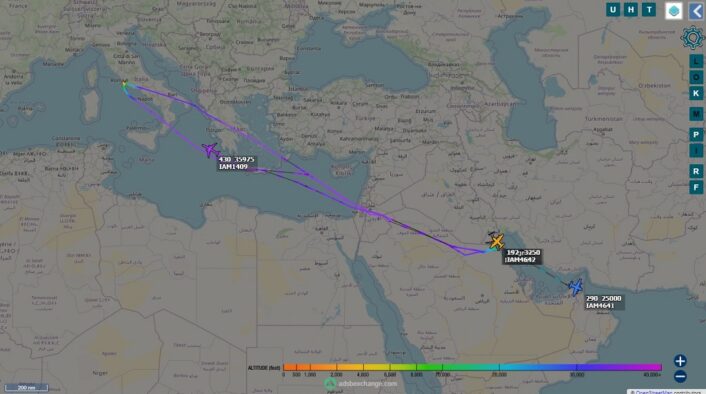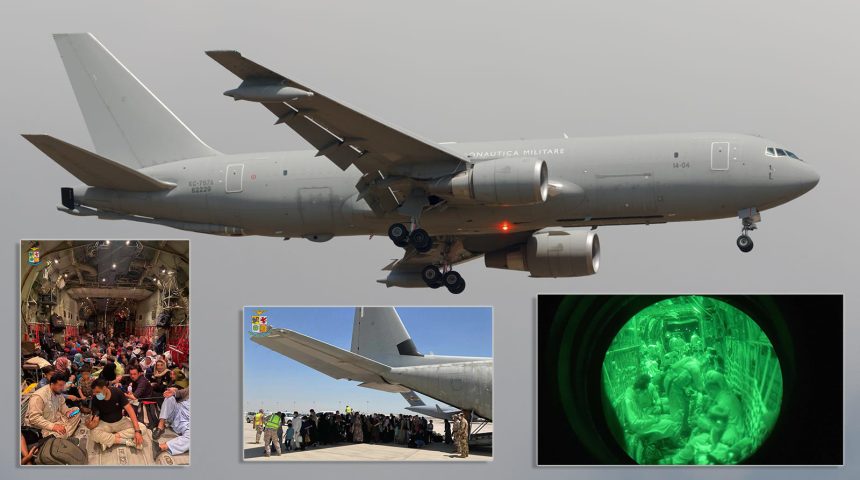As part of “Aquila Omnia”, the Italian Air Force deployed 4 C-130J cargo aircraft to transport personnel from Kabul to Kuwait, where 3 KC-767A tankers are then ready to fly the evacuees to Italy.
Images of the chaos at Hamid Karzai International Airport in Kabul, Afghanistan have continued to show up every day on televisions and social media since the beginning of the massive evacuation effort that followed the fall of the Afghan government and the Taliban takeover. While tragic scenes like the ones we saw in the early days, with people swarming the runways and trying to escape hung on the outside of aircraft, are not happening again, the chaos is still immense and countless people are outside the airport waiting for a chance to escape.
According to the Italian NGO Emergency, at least 10,000 Afghan people are estimated to be waiting in hope to be evacuated in Kabul, adding up to foreign nationals that were already in the process of being evacuated. The number, however, might be much higher, as the United States government stated that they might need to evacuate about 20,000 Afghan nationals alongside 10,000 to 15,000 U.S. citizens. Many of these Afghan people are former collaborators of the Coalition forces and so the various countries involved in Afghanistan are evacuating them as they might face retaliation by the Taliban.
Arrivate nella notte a Fiumicino altre 194 persone dall’#Afghanistan grazie al ponte aereo realizzato dalle #ForzeArmate🇮🇹 con velivoli da trasporto #C130 J e KC767A dell’#AeronauticaMilitare
Op. #AquilaOmnia pianificata e diretta dal #COVI #Difesa#UnaForzaperilPaese#20agosto pic.twitter.com/hsn44s0nOA
— Forze Armate StatoMaggioreDifesa (@SM_Difesa) August 20, 2021
Among the forces involved in the evacuation of civilians, there are the Italians, which already started to evacuate about 230 Afghans in June as part of Operation Aquila (Eagle), the Italian Ministry of Defense effort to protect from retaliation the Afghans who worked with the Italian forces and their families.
Now, following the fall of Afghanistan, Operation Aquila Omnia has been launched. Omnia is the Latin translation for “whole” or “totality”, meaning that the Italian government intends to evacuate everyone who collaborated with the Italian forces and leave no one behind.
“The commitment of the [Ministry of] Defence is maximum to evacuate those who collaborated with Italy. Our commitment is to work with the maximum effort to complete the evacuation plan for Afghan collaborators, activists and those exposed to danger”, said the Italian Ministry of Defence Lorenzo Guerini. Eagle Omnia is planned and supervised by the Comando Operativo di Vertice Interforze (Operational Command of the Joint Forces), which directed the deployment of three KC-767As of the 14th Stormo (Wing) and four C-130Js of the 46th Brigata Aerea (Air Brigade) of the Italian Air Force to carry out the evacuation. The MoD press releases erroneously state that four KC-767s are involved in the operation, however both the Italian Air Force and data from ADS-B tracking websites confirmed that only three tankers are involved.
L’arrivo a Fiumicino del
KC767 dell’#AeronauticaMilitare
con a bordo 202 persone.
Prosegue il ponte aereo della #Difesa per ex collaboratori e loro familiari #Afghanistan#19agosto pic.twitter.com/41lPfyjb5q
— Ministero Difesa (@MinisteroDifesa) August 19, 2021
The seven aircraft have been deployed to Al Mubarak Air Base, co-located with Kuwait International Airport, from where Italian KC-767s also fly air-to-air refueling sorties to support the Counter Daesh Coalition. The evacuation missions start from Kuwait, with the C-130s departing from Al Mubarak Air Base and then flying over the Persian Gulf, the Gulf of Oman and then Pakistan before reaching Kabul (the same route flown by many other airlifters during the last week and during these years of Afghanistan operations).
I nostri equipaggi decollano ogni giorno per nuove missioni senza conoscere le emozioni dalle quali saranno travolti.Ed è così che lo sguardo di 2 bambine afghane verso il futuro, su un KC767A mentre scorgono le coste italiane, diventa simbolo di speranza https://t.co/ShLxOmKQBs pic.twitter.com/o2nIet30a8
— Aeronautica Militare (@ItalianAirForce) August 19, 2021
The evacuation of the Afghan collaborators and their families was already in progress, as we mentioned before, but the rapid decay of the situation in the country prompted a rapid acceleration of the operation with the maximum urgency. However, it took a couple of days before the air bridge became operational with all seven aircraft on August 17, 2021. In the meanwhile, the first evacuation between August 15 and 16 was carried out by a KC-767 that flew directly from its home base at Pratica di Mare Air Base to Kabul.
Here’s a shot of the @ItalianAirForce KC-767 landing at Rome Fiumicino airport earlier today with 74 people (embassy personnel and Afghan workers) evacuated from Kabul. pic.twitter.com/4ashGq3IPR
— The Aviationist (@TheAviationist) August 16, 2021
The KC-767 brought to the Afghan airport also a team of the Carabinieri’s 1st Paratroopers Regiment “Tuscania”, a special operations unit usually tasked, among their other roles, with the protection of embassies and diplomatic personnel. The role of the Carabinieri is, in this case, not only to evacuate the personnel of the Italian Embassy, but also to provide security for the evacuation of the Afghan nationals that are waiting to board the C-130s.

The first KC-767 direct evacuation flight granted enough time to assess the situation and plan how to proceed, with the other aircraft involved in Operation Aquila Omnia deploying to Kuwait as the KC-767 was returning to Italy. As soon as the first C-130s arrived in Kuwait, they began flying into Afghanistan two times a day, increasing the frequency once all the aircraft completed the deployment flight.
on board #46BrigataAerea C-130J, one of the #Aeroanutica Militare units engaged in the transport of people from #Kabul to #Italy. Our aircrews are operating tirelessly to save lives! pic.twitter.com/THbTxb0grB
— Aeronautica Militare (@ItalianAirForce) August 21, 2021
The route in and out of Afghanistan has been identified thanks to data from ADS-B tracking websites, where the KC-767 are visible for the entire duration of their flights, while the C-130s are transmitting their signal only over the Persian Gulf. The same data also allowed us to verify the number of aircraft deployed, as we mentioned a few lines back, their serial numbers and their approximate route. The imprecisions about the route tracking are not only due to the transmission of the signal from the aircraft (as the Mode-S might be either switched off or encrypted, the latter known also as Mode 5), but also due to the lack of an adequate number of ADS-B feeders in the area and thus the impossibility to precisely triangulate the position.
Ancora uno scatto realizzato a bordo di un C130J della #46BrigataAerea uno dei reparti dell’#Aeronautica Militare impegnato nel trasporto di persone da #Kabul all’#Italia. I nostri equipaggi operano ormai da giorni senza sosta per garantire il ponte aereo pic.twitter.com/MiGXYbAQ8h
— Aeronautica Militare (@ItalianAirForce) August 21, 2021
Speaking about the serials, for the KC-767s there are MM62229/14-04, MM62226/14-01 and MM62227/14-02, while for the C-130 there is a single standard J model MM62178/46-43 and three of the longer J-30 model (the fuselage is 15 feet longer than the J, increasing the cargo space) MM62195/46-61, MM62194/46-60 and MM62189/46-55. As an interesting side note, it appears that none of the Italian C-130s wears its serial number as it was seemingly painted over, leaving only the two letters MM (Matricola Militare/ Military Serial) without the actual number.
Once in Kabul, the C-130s load about 100 people per flight after they have been checked and identified by Italian troops, which were deployed to the airport before the beginning of the evacuation. According to some sources, each aircraft can only stay on the ground for about 30 minutes, as there is not enough free space on the airport ramps for everyone to land. Kabul is the only airport still operational in Afghanistan, so this kind of timing is needed to grant every aircraft enough space to safely land, load the personnel and depart again.
After leaving Kabul, the C-130s land at an unspecified location for a technical stop to refuel and then fly back to Kuwait. Once there, the passengers of the C-130s are transferred on the KC-767 that will take them to Rome Fiumicino airport in Italy, where they are screened to check if there is anyone in need of medical assistance and then transferred in a safe location. The Italian Army granted the use of some of its barracks for this, where the Afghans will be assisted while waiting for resettlement in Italy.
The Italian crews are flying day and night in and out of Kabul, with the MoD providing regular updates about the operation. As mentioned in the official statements, there are about four C-130J flights each day, now that the evacuation is in full swing, followed by at least two KC-767 flights to Italy. The difference in the number of flights is obviously due to the different capacity of the two aircraft types, with the KC-767 transporting up to 200 passengers in the full pax configuration and the C-130J and C-130J-30 transporting up to 92 and 128 passengers respectively.
The Italian MoD stated that about 1,500 people have already been evacuated and about 1,000 of them arrived in Italy, including the ones already transferred in June during Operation Aquila Omnia. An estimate of the total number of people to be evacuated by Italy has not been provided yet, but the Ministry mentioned that the operation will continue without pause until every person who is at risk for having collaborated with Italy is out of Afghanistan. However, a few exceptions were reported, with some of the former collaborators deciding to stay behind and to not leave Afghanistan.
Aquila Omnia once again proves the importance of the KC-767s. As already explained in detail, the 767s are among the most in-demand assets of the Italian Air Force: while their primary role is AAR (Air-to-Air Refueling), the KC-767A, in both Cargo, Combi and Full Pax configurations, can be used for strategic transport missions as well as MEDEVAC (Medical Evacuation) or Bio-Containment missions. The latter have become particularly important last year, with the outbreak of the Coronavirus pandemic, when the wide-bodies carried out both repatriation flights of Italian citizens stranded abroad by the first wave of lockdowns, and biosafety containment missions of Covid-19 patients.
The KC-767 fleet has proved to be a force multiplier also for NATO and it’s worth highlighting that the Italian 767 tankers are also assigned to the EATC (European Air Transport Command), the multinational command headquartered at Eindhoven AB in the Netherlands whose goal is to improve the effectiveness and efficiency of the member nations military air transport efforts by “pooling and sharing” assets to optimize resources and fill the shortfall of EU tankers highlighted by the Libya Air War in 2011.
Among the measures the Italian government included in the new multiyear defense planning document (Documento Programmatico Pluriennale della Difesa) for 2021-2023, which illustrates the funding needed by the Italian military to sustain and modernize its forces, there is also the procurement of two new KC-767 tankers in their latest version and to upgrade the aircraft already in service to the equivalent U.S. Air Force standard.
As we have explained in our detailed post on the document that you can find here, “while not explicitly stated, this should mean that the Italian Air Force will become the next operator of the KC-46 Pegasus tanker, although it is not known if the Italian tankers will assume the new designation or retain the older KC-767 one, maybe as KC-767B to differentiate from the original KC-767A currently in service. With this program, Italy will join Israel and Japan as export operators of the KC-46 Pegasus, with the latter also operating the KC-767A. The Italian government will invest 1,410 million Euro in the program, even if the total funds needed are still being defined. Following the lessons learned during the COVID-19 pandemic, which saw an extensive use of the KC-767 to evacuate Italian citizens, the tanker program also includes new StratEvac (Strategic Evacuation) kits to safely transport patients who need intensive care.”









